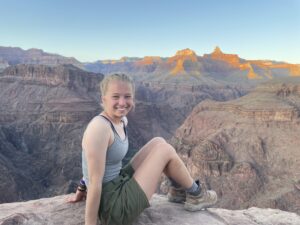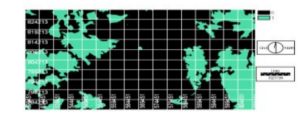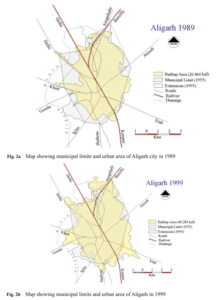Mitchell Chapter 5:
Key concepts and definitions:
Boundary: a polygon that is placed on top of features and is used to select features within in order to list or summarize features or in order to combine the boundary and features to create summary data. Boundaries can be shaded areas that go in front or behind the outer area (this emphasizes the area itself) or they can be thick lines (this emphasizes the inner area).
Drawing areas and features: a method that allows you to visually find out whether features are inside or outside the boundary. This method is for working with one area.
Selecting the features inside the area: a method that provides a list or summary of features inside the boundary. This method is for working with one area.
Overlaying the areas and features: a method that determines which features are inside which boundaries and also summarizes features by area. This method is for working with several areas or single areas. Using the raster model is more efficient than using the vector model.
Count: the total number of features inside an area or boundary.
Frequency: the number of features with a certain value inside an area or boundary displayed as a table or chart.
Slivers: very small areas where areas are slightly offset from overlaying. Slivers should be merged into adjacent larger areas according to minimum mapping unit and data accuracy guidelines.
Minimum mapping unit: the smallest area input in a dataset.
Notes and Questions:
- Finding what’s inside a single area lets you monitor activity or summarize information about the area and finding what’s inside numerous areas lets you compare the areas
- You want to include features that are partially within the boundary if you are gathering a list or count of features
- When looking to determine the amount of something within a boundary, you would only include the portion inside the area
- Am I correct in understanding that overlaying the areas and features is selecting the features inside the area just with an additional step and that selecting the features inside the area is drawing areas and features just with an additional step?
Mitchell Chapter 6:
Key concepts and definitions:
Traveling range: determines what’s within a set distance of a feature. Distance, time, or cost can be used.
Travel costs: often termed the impedance value. Time, distance, and money are very common.
Planar method: used for calculating distance on a flat earth and in a relatively small area.
Geodesic method: used for calculating distance taking into account the curvature of the earth and in a relatively large region.
Inclusive rings: useful for determining how the total amount of something increases as distance increases.
Distinct bands: useful for comparing different distances to other characteristics.
Spider diagram: formed when GIS draws a line between each location and its nearest source. They are useful for comparing patterns between two or more source points.
Junctions: points where edges meet.
Turns: used to determine the cost to travel through a junction.
Edges: street segments or lines.
Turntable: a data table that contains the junctions which you want to assign a cost to.
General boundary: it connects the farthest reaches of the selected segments (forms a blob).
Compact boundary: it outlines the selected segments.
Mask layer: used for blocking the assignment of cost values to cells. You would assign the cells a very high value or no value at all to do this.
Notes and Questions:
- Area of influence is typically measured using straight-line distance (putting a boundary of a certain radius, depending on the distance specified, around the chosen feature)
- Travel movement is measured over a geometric network (for example roads). Travel costs can also be applied to this
- Cost over a surface is used for overland travel and is useful for showing rate of change. It uses the raster model
- When finding features near several sources you need to create separate straight-line buffers otherwise you won’t know which source (or sources) the feature is near
- You should specify the maximum distance when finding what’s nearby
- Distance ranges are created using graduated colors
- If you need to be specific when calculating travel time (cost) include turns and stops
- The source should be a different, distinguishable symbol than other features
- To create a cost layer based on a single factor reclassify an existing layer for the attribute you want, and to create a cost layer based on numerous factors combine all the layers together after reclassifying each input layer
- I understand the theory of how to find what’s nearby but I don’t know the technical steps to take
Mitchell Chapter 7:
Key concepts and definitions:
Time patterns (trend, before and after, and cycle): a trend map represents change between two or more times, a before and after map represents change preceding and following an event, and a cycle map represents change over a recurring period of time.
Tracking map: shows the position of a feature or features at several times. This is useful for showing incremental movement and geographic phenomena.
Trendline chart: shows a relative value as well as that value’s growth over time.
Notes:
- You can map change by creating numerous maps showing the condition of features at each time or by calculating and mapping the difference in value for each feature
- When mapping trends you need to determine the time interval
- When mapping cycles you can map either snapshot or summarized data
- When mapping before and after you want to use snapshots as close as possible to the event
- When mapping discrete events you need to use summarized data and when mapping continuous data you can map summarized or snapshot data
- Time series maps are good for showing changes in boundaries, values, or surfaces. You create one map for each time; however, you shouldn’t have more than six maps
- A tracking map is good for showing movement in boundaries, lines, and discrete features
- When mapping change in magnitude use the same classification scheme for all the maps
- Quantile and equal interval schemes are useful for comparing values over time
- You can generalize categories if historical categories vary from existing categories
- To show movement in a trend map use different colors for each time period, to show movement in a before and after map use one color to represent the before and one color to represent the after, and to show movement in a cycle map use different colors for each time period
- To emphasize the “from” in “from → to” change, map those categories in shades of the same color, and vice versa if you want to emphasize the “to”


